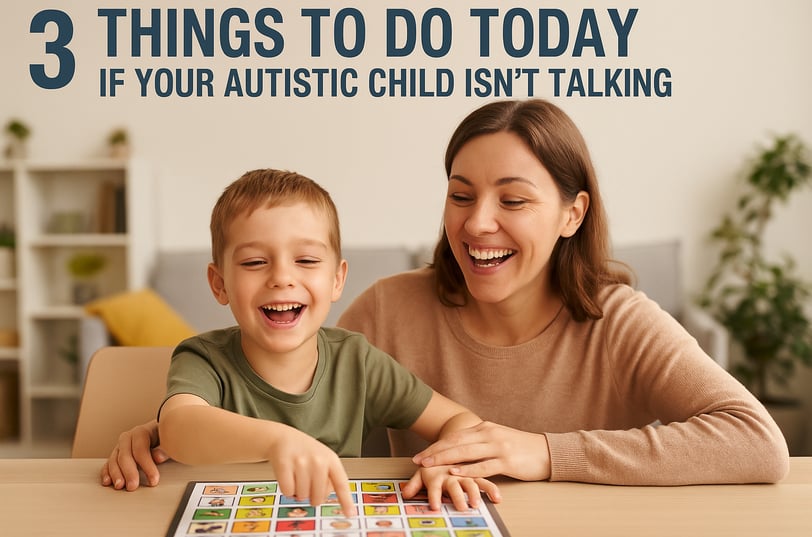3 Things To Do TODAY If Your Autistic Child Isn't Talking
Discover 3 therapist-approved strategies you can start TODAY to help your non-verbal autistic child begin speaking—no pressure, just real-life tips!
Autism Mom
3 min read


3 Things To Do TODAY If Your Autistic Child Isn’t Talking
If your autistic child isn’t talking yet, just know that you’re not alone and there is hope! My son was non-verbal until he was almost 5 years old. Now, he's almost 7 and he’s holding short conversations and verbally requesting his wants and needs! Your child can also start making progress today with these three simple, no-pressure strategies that I've learned from our therapy team, along with tips and real-life strategies from fellow autism parents just like you!
Table of Contents
1. Don’t Wait for Words—Model Language in the Moment
2. Comment More, Question Less
3. Use Visual Supports Daily
4. Frequently Asked Questions
5. Next Steps For Speech Success!
Download your free PDF guide: 5 Easy Ways to Encourage Speech in Your Autistic Child
Watch My YouTube Video: 3 Things To Do TODAY If Your Autistic Child Isn't Talking
1. Don’t Wait for Words—Model Language in the Moment
Your child may be non-verbal, but that doesn’t mean they’re non-understanding.
One of our speech therapist’s top speech strategies for autism: model the words you want your child to learn—right when it matters. This verbal communication technique builds comprehension without pressure.
How to Model Language
Use short, clear phrases.
Instead of saying “Do you want the banana?”
Say this instead: "Banana? You want banana?. Mmm Banana!"
Repeat the word three times and then give the item to them.
Pair words with routines (mealtime, playtime, diaper changes, etc).
During diaper changes, try saying: "Wipe Bum! Clean Diaper! All Done!"
Incorporate signs or gestures and sing if your child loves singing or music!
Over time, your child links the spoken word to the object or action—and starts absorbing language naturally.
2. Comment More, Question Less
Reduce pressure and give natural language input.
Questions can feel like tests to an autistic child. SLP (speech-language pathologist) advice: swap out questions for comments to flood your child’s world with language.
Instead of asking: “What’s that?”
Comment on what you're seeing: “It’s a red car!”Instead of asking:“Do you want to slide?”
Comment on what they're doing and narrate their actions: “You’re climbing up the slide—almost there—ready, set, weee!”“Instead of asking: "Can you say dog?”
Comment on what you're seeing and what is happening in the moment: “Dog! The dog is running!" or "Dog! The dog is barking!"
Swap questions for comments throughout your day! Narrate your child’s world to boost language without pressure.
Narrate one daily routine today—bath time, snack, or a walk around the block—and notice the difference!
3. Use Visual Supports Daily
Before words, pictures gave our son a voice.
Visual supports are key for many autistic children. They’re concrete, clear, and empowering.
Setting Up Visual Supports
Create or purchase a simple visual communication board with cards for “help,” “more,” “all done,” “go,” etc.
Display visuals on the fridge, pantry, the bathroom or any other area where you child regularly will need or want something
Encourage pointing or hand-leading to the picture before responding.
Celebrate every attempt with enthusiastic language and tone:
“You need help?! Mommy will help! Show me!”
One day, my son pointed to “help” photo on his communication board, and then surprised me by saying, “Help me.” That breakthrough happened because we gave him another way to express himself first and I'm so happy I was able to catch the beautiful moment on video!
And check out this other amazing moment I caught on video of my 4-year old non-verbal son saying "I love you" just randomly out of nowhere one night! Check out the video here!
4. Frequently Asked Questions
How long until my child starts talking? Every child is unique. With consistent modeling, commenting, and visuals, many parents see word attempts within a few weeks—though full speech may take months or longer.
Can I combine these tips with AAC or PECS? Absolutely! Augmentative and Alternative Communication (AAC) and Picture Exchange Communication System (PECS) fit perfectly alongside these strategies.
What if my child resists the visuals? Try keeping visuals simple to start with (1–3 items at a time) and follow your child’s interests and daily routine schedule. Swap out cards and pictures when needed as interests and routines change over time.
5. Next Steps For Speech Success!
Download your free PDF guide:
Watch My YouTube Video:
Check out these other blog posts
Try one tip today—model language at breakfast or narrate bath time!
From one autism parent to another: you’re doing an amazing job, and every small step counts!
Share with another autism parent who might also find these tips helpful!
